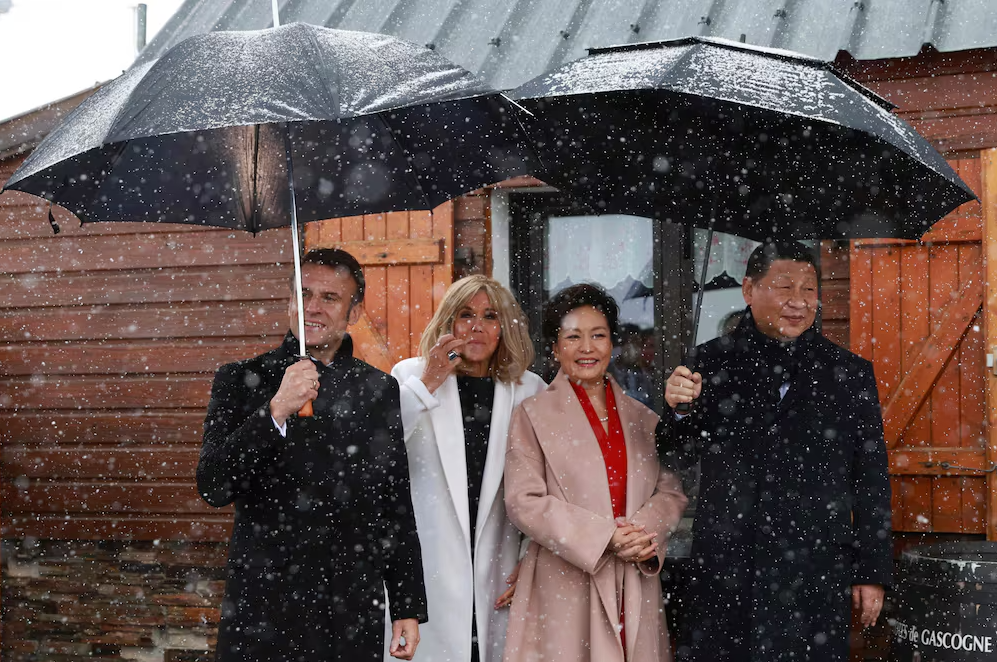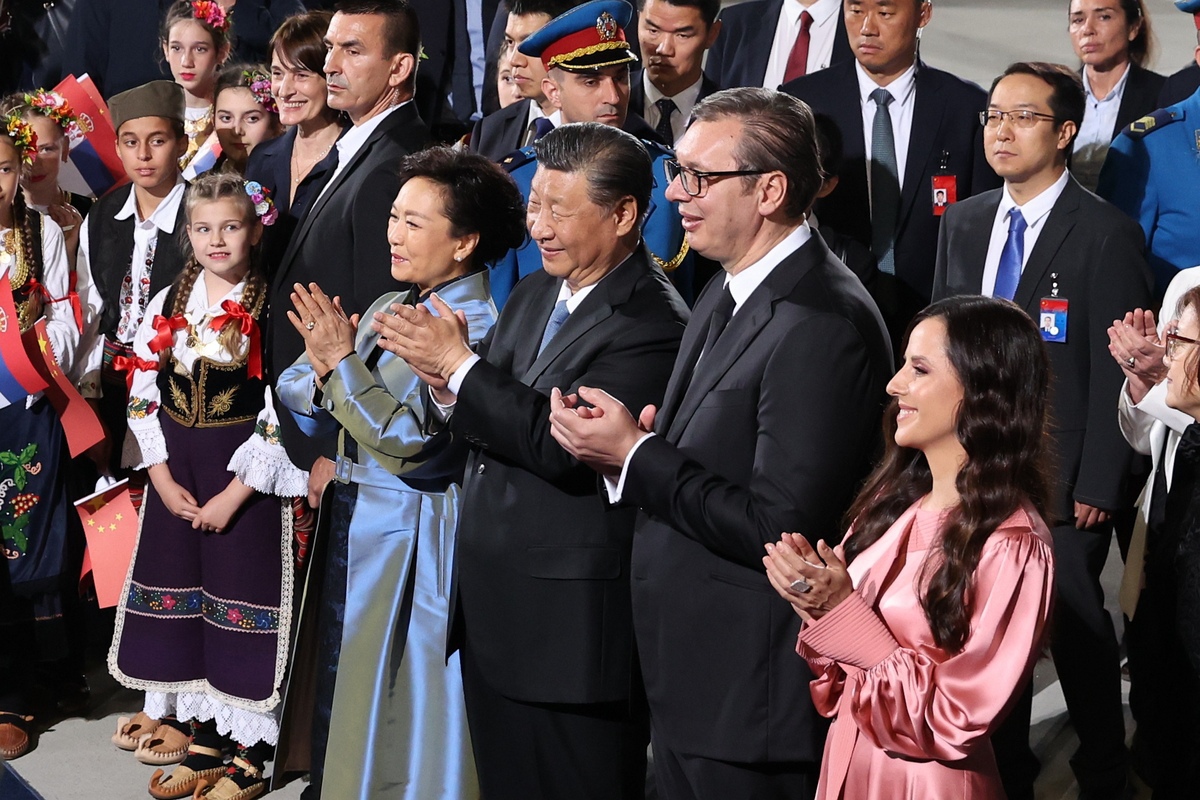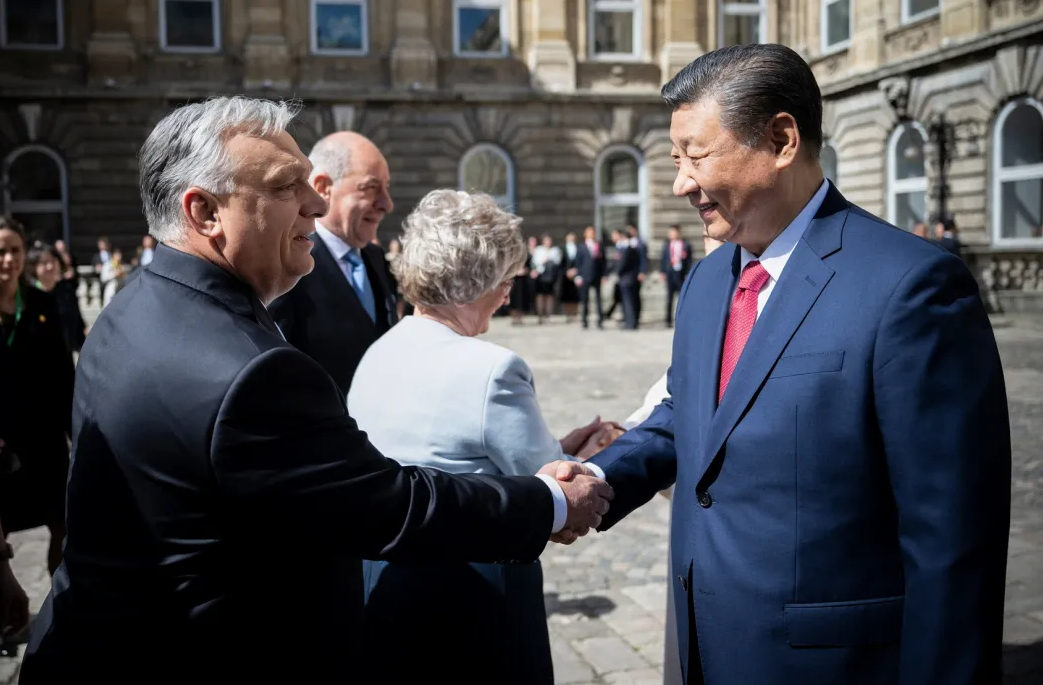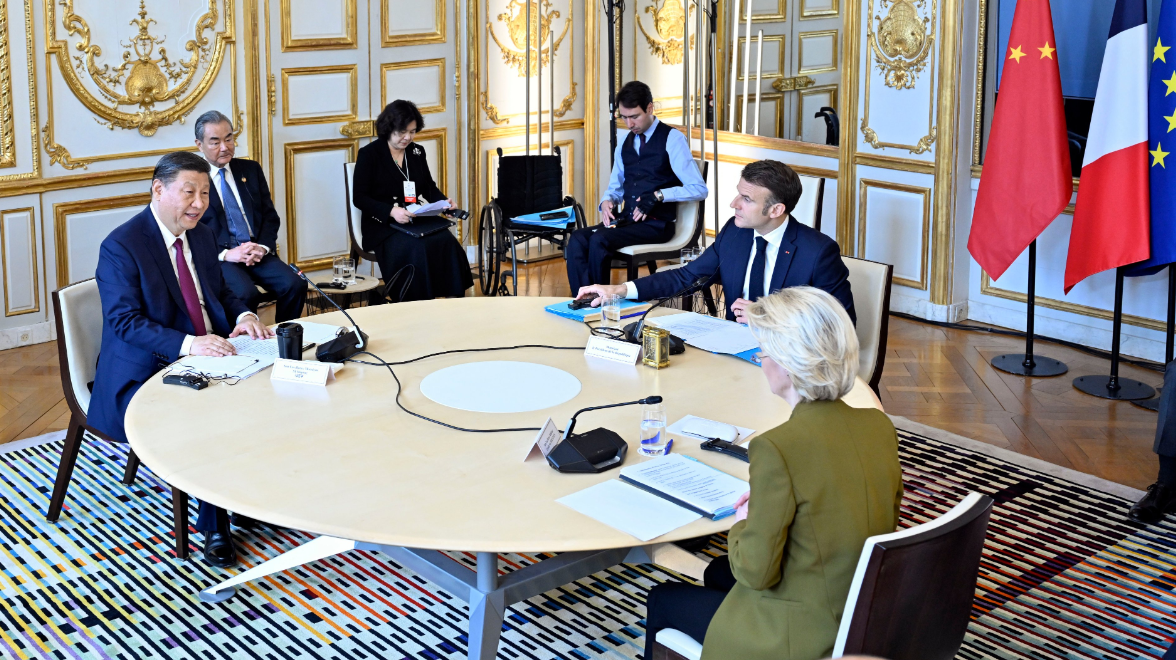
French President Emmanuel Macron, Chinese President Xi Jinping and their wives Brigitte Macron and Peng Liyuan spent time holding private talks at the Col du Tourmalet in Hautes-Pyrenees Department of France. May 7, 2024. AFP
President Xi Jinping’s recent voyage to Europe is the best barometer for measuring the current state of China-EU relations. A swift evaluation reveals more unsettling signs than promising advancements.
The visit occurred amid significant shifts since Xi’s last journey five years ago. Today, China’s economy faces a myriad of challenges, while Europe grapples with security anxieties.
These developments influenced the discussion agendas, highlighting divergent interests. Europe’s foremost concern, the war in Ukraine, prompts leaders to urge Xi to take action. Meanwhile, the EU intensifies scrutiny of China through anti-subsidy probes, targeting key sectors. In response, China deploys diplomatic strategies and retaliates, including export restrictions on critical raw materials, aiming to penalize European de-risking efforts and economic security policies.
While the trip filled a diplomatic gap, the likelihood of an immediate resolution for the issues discussed seems slim. Notwithstanding agreements and promises, core tensions persist. This pattern mirrors EU leaders’ appeals to Xi in December 2023, which have thus far yielded minimal results.
This deadlock raises questions about the broader state of the relationship. Has European trust in China improved after the visit? Why do recurring EU concerns seem non-negotiable for China? Ultimately, while agreement on secondary issues is conceivable, the underlying structural challenges of the partnership remain unaltered, overshadowing any superficial consensus.
France, First Strategic Choice amid Evolving EU-China Policy
Xi’s itinerary encompassed visits to France, Serbia, and Hungary. Given the importance of symbolic gestures in Chinese diplomacy, it’s crucial to capture the rationale behind this unconventional selection.
First of all, China’s foreign policy in Europe places emphasis on Germany and France as top priorities, each embodying different dimensions of influence.
Germany’s enduring status as China’s top trading partner for eight consecutive years underscores a profound reliance, which has escalated from 5% to 20% over the past two decades, with an approach seemingly entrenched in outdated paradigms. Chancellor Scholz’s solo visit to China preceding Xi’s trip highlights Berlin’s conflicted China policy, potentially undermining EU cohesion and Germany’s overall reputation. Scholz declined to join Macron and von der Leyen in meeting with Xi. These moves contradict his call for a “change in approach” in November 2022.
In contrast, France’s principled diplomacy and rising prominence amid U.S.-China tensions garners respect, positioning it as the reliable ally for enhancing EU relations. Xi’s visit to Paris acknowledges aligned Franco-Chinese strategic interests, signaling France’s reliability and political credibility. Although framed as commemorating the 60th anniversary of Franco-Chinese diplomatic ties, deeper implications emerge. In 2023, during the 50th anniversary celebration between China and Spain, Xi didn’t visit Madrid. Instead, he briefly hosted Prime Minister Sanchez in Beijing, contrasting with the extensive engagements with other leaders.
Despite Macron’s stance on European ‘strategic autonomy,’ underscored by his recent speech outlining a survival strategy for the EU amidst significant threats, his doubling down on this principle reflects a growing assertiveness in European foreign policy, shaping the dynamics of China-EU relations.
Macron’s focus on bolstering ties with China while asserting greater sovereignty, apart from American influence, aligns with Xi’s preferences. This contrasted sharply with his acknowledgment of the risks stemming from China’s overcapacities and extensive exports to Europe—a point Xi dismisses. Nonetheless, such concerns are accepted within China; Professor Lu Feng of Peking University conceded that supply overflows prevail in several sectors.
This European drive for strategic autonomy through deeper integration and unified defense would impact its dealings with the U.S., NATO, and China, unfolding in three distinct phases. Initially, prioritizing autonomy from the U.S. would reshape the EU’s transatlantic strategy. Subsequently, this shift would affect NATO, enhancing the EU collective defense capabilities. Ultimately, these shifts would facilitate the EU to engage with China more equitably, empowering it to pursue its interests autonomously.
Conflicting views on China persist among France, Germany, and the President of the European Commission. Macron advocates for careful engagement, while von der Leyen leans towards alignment with Washington’s agenda. Germany prioritizes maintaining business as usual. However, China’s subsequent actions confound efforts for greater coherence and sensibility in European policies.

Chinese President Xi Jinping and his wife, Peng Liyuan, are welcomed on May 7, 2024 by Serbian President Aleksandar Vucic (front, second from right) and his wife, Tamara Vucic (front, right), upon their arrival at Nikola Tesla Airport in Belgrade, capital of Serbia. (Photo: WANG Zhuangfei / CHINA DAILY)

Chinese President Xi Jinping (right) shakes hands with Hungarian Prime Minister Viktor Orban (left) prior to a welcoming ceremony in Buda Castle of Budapest, Hungary on May 9, 2024. (Photo: Vivien Cher Benko/Pool/AFP)
Odd Choices: Serbia and Hungary
Choosing Serbia and Hungary for a European visit may appear unconventional, yet it underscores China’s strategic interests in the region and beyond. Providing context is crucial for elucidating the geopolitical significance, and impact.
Firstly, despite their roles as China’s vassals in Central and Eastern Europe, Hungary, a EU member since 2004, and Serbia, EU applicant since 2009 (the process is merit-based), wield limited influence over broader European policymaking. Macron previously cautioned against China’s “divide and conquer” tactics, advocating for unified engagement through EU institutions.
Secondly, despite significant economic gaps—Hungary’s economy is one-third the size of Shanghai’s, Germany’s 25 times larger, and France’s 18 times; Serbia trailing at a third of Hungary’s—China has funneled over 60% of its European investments into these nations. Hungarian leader Orbán dismissed terms like ‘overcapacity’ and ‘de-risking’ as mere “rhetoric” and “ideological.”
Thirdly, Xi’s decision to visit Serbian President Vučić’s, especially in the wake of his controversial election win, and Orbán, due his confrontational stance towards EU institutions and values, suggests support for populist leaders—a stance met with caution in Europe. Instead of equal nation-to-nation visits, the move appears to symbolize leader-to-leader endorsements.
However, from a geopolitical perspective, China sees strategic benefits in visiting these seemingly inconsequential nations for three primary reasons.
Initially, Serbia and Hungary share close ties with Russia, aligning with Beijing and suggesting a geopolitical axis.
Then, Xi’s visit to Serbia coincided with the 25th anniversary of their embassy bombing, granting a platform to criticize NATO. There, Xi juxtaposed the accidental deaths of three Chinese citizens with the brutal Yugoslav wars. His proclamation of “never allowing such tragic history to repeat itself” resonated with diplomatic theatrics, suggesting a China-Serbia bond forged with the equal measure of blood from their compatriots.
Although the setting may carry symbolic weight, expressing opposition to NATO’s global security role could likely be achieved more effectively, especially given the timing of issuing such a statement while welcoming Putin to Beijing shortly afterward. This presents a difficult puzzle to reconcile, considering Putin’s accountability for the deaths of thousands of innocents.
Finally, on the trading front, progress continues on the Budapest–Belgrade railway, potentially the largest Belt and Road Initiative project in Europe. Executed by Chinese contractors, this project links the capitals of Hungary and Serbia, expanding the corridor for Chinese goods entering Europe from Greece. This underscores China’s strategic infrastructure investments and long-term plans in the region.
The move, therefore, could hint at a potential shift in China’s European strategy by strengthening ties with peripheral and less influential EU nations, which nevertheless serve as entry point for China into the single market. Furthermore, it suggests that EU institutions and other states may not hold a similar importance to China’s interests.

Chinese President Xi Jinping (1st L), French President Emmanuel Macron (2nd R) and European Commission President Ursula von der Leyen (R) hold a trilateral meeting at the Elysee Palace in Paris, France, May 6, 2024. (X account of Hua Chunying)
Europe’s Dual and Stalled Concerns over Ukraine and China
Europe faces two main concerns: the war in Ukraine and China-related economic issues, including trade imbalances, market access, asymmetries, and overcapacity. China is revealing a reluctance to take action on these matters. If the interconnectedness of these factors remains unaddressed, competitive pressure will intensify further.
Meanwhile, the war in Ukraine stands as the most complex issue in China-EU relations. Despite China’s commitment to abstain from selling dual-use goods to Russia and the awkward “Olympic truce” agreed by Xi-Macron, Europe is perplexed by China’s inaction. Xi recalled to stress Russia “that nuclear weapons must not be used.” However, the war tops Europe’s concerns, prompting unattended requests for China’s help.
On the trade front, EU leaders remain committed to economic rebalancing, suggesting that tensions may escalate. Von der Leyen stated the EU’s dedication to employ defence instruments. She specified, we “cannot absorb China’s surplus production… I have encouraged to address these structural overcapacities.” Consequently, EU leaders seem driven to use the economic security toolbox against China, leaving them little reason to hold back. This suggests Xi’s efforts to ease tensions for Chinese state-controlled enterprises might have fallen short.
Furthermore, China’s interests projected during this trip indicates it still views Europe as a collection of sovereign states, some considered friends and others less so. While this approach may have worked before, it is now challenged by geopolitics. True European empowerment entails relinquishing national sovereignties and growing politically and economically for effective competition, rather than the opposite. Indeed, China should consider whether this strategy is the most advantageous for accomplishing its main goal: Xi departed with the unique satisfaction of having a few Europeans share his defiance of U.S. global hegemony.
Overall, while this trip was filled with grandiose declarations, and leaders’ meetings are essential for building future agreements, the impression conveyed by China to the EU is somewhat perplexing, possibly interpreted as a revival of outdated divide-and-conquer tactics. This may shift the EU’s China policy towards a more assertive, pragmatic stance driven by realpolitik. Regrettably, despite all the diplomatic efforts both sides have made in the last two years, the perception of growing rivalry seems destined to solidify.
